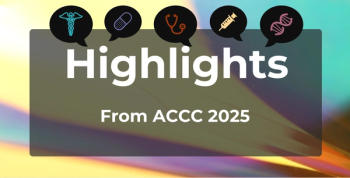
No CRS Seen in First 10 Patients in Teclistamab Pilot With Prophylactic Tocilizumab

Results for the first 10 patients offer promising signs for giving patients with multiple myeloma a prophylactic dose of tocilizumab before they are treated with the bispecifc antibody teclistamab.
The first 10 patients with multiple myeloma given a prophylactic dose of tocilizumab prior to treatment with teclistamab have not experienced cytokine release syndrome (CRS) or immune effector cell-associated neurotoxicity syndrome (ICANS), according to data from a pilot study presented today at the 2024 annual meeting of the American Society of Clinical Oncology (ASCO).1
Early findings from the OPTec study (NCT05972135) could signal a breakthrough in patients’ ability to receive teclistamab, a bispecific antibody
Teclistamab is the only FDA-approved therapy with weight-based dosing to target B-cell maturation antigen (BCMA) on multiple myeloma cells and CD3 on T-cells to activate an immune response.2 The therapy has a step-up dosing schedule, which allows some flexibility on when it is administered to deal with CRS or ICANS.
The pilot, led by Robert M. Rikfin, MD, medical oncologist/hematologist of Rocky Mountain Cancer Centers of Denver, Colorado, is based on findings from a cohort of the
The purpose of the pilot is to evaluate whether giving a prophylactic dose of tocilizumab can prevent neurologic AEs when teclistamab is administered in a community setting. This requires carefully following patients to ensure that tocilizumab, normally given at the onset of CRS, does not alter the efficacy of the therapy.
“All of the safety endpoints are early,” cautioned Rifkin, who explained the pilot’s methodology.
This process required investigators to treat 5 patients, present findings to the data review committee (DRC); treat 5 more patients, then present those findings to the DRC. Under the study’s protocol, with the DRC’s blessing, the study can then expand from 4 sites to 12 and enroll an additional 40 patients.
“We’ve completed our first 10 patients,” Rifkin said in an interview. “The next data review committee will be within the next 2 weeks, and we're optimistic we'll be able to then open it up and accrue the remaining 40 patients.”
In addition, he said, “A talquetamab arm will be added,” referencing the bispecific antibody sold as Talvey, which is a GPRC5D-directed CD3 T-cell engager.
Both teclistamab and talquetamab are made by Johnson & Johnson, which sponsored the study with the Sarah Cannon Research Institute.
Rifkin was enthusiastic about the results, but he noted that giving patients teclistamab will still require a community practice to have resources to properly administer the therapy, which is given through subcutaneous injection. Patients must still have a caregiver present, there is still the likelihood of fever, and results show that other AEs such as headaches or nausea remain.
“It’s still a team effort,” Rifkin said. One approach being considered is that after a few weekly doses, patients in the study could return to their local oncologist, because the window for CRS or ICANS to appear will have passed.
Methods. Study protocol call for the following:1
- Patients eligible for the pilot must be at least 18 years old and have received at least 4 prior lines of therapy for multiple myeloma.
- Those with rapidly progressing multiple myeloma, active infection, or central nervous system involvement are excluded.
- Tocilizumab is given in doses of 8 mg/kg intravenously 2 to 4 hours prior the first dose of teclistamab in an outpatient setting; teclistamab is then given weekly for 12 cycles until disease progression or unacceptable toxicity.
Results: Data presented at ASCO include the following:1
- Median age was 70 (53 to 83) years.
- Six female patients and 5 male patients have enrolled.
- Patients received a median of 8 (5 to 11) prior systemic therapies.
- Criteria for stopping, which are grade 3 or higher CRS or neurotoxicity/ICANS were not met for the first 11 patients.
- Common AEs were headache (5), nausea (5), neutropenia (4), and injection site reaction (4).
- No patient had CRS or ICANS.
- No patient was hospitalized due to tocilizumab or teclistamab.
- One patient had a grade 2 infection of the upper respiratory tract and urinary tract; 2 patients had 1 infection each of respiratory tract or yeast infection.
- 10 patients completed the step-up dosing regimen.
- 1 patient with diffuse bony lesions and pain did not complete the regimen and withdrew due to physician’s decision; the patient later died.
References
- Rifkin RM, Schade HH, Simmons G, et al. OPTec: A phase 2 study to evaluate outpatient (OP) step-up administration of teclistamab (Tec), a BCMA-targeting bispecific antibody, in patients (pts) with relapsed/refractory multiple myeloma (RRMM). J Clin Oncol. 2024;42(suppl 16); Abstract 7528. doi:
10.1200/JCO.2024.42.16_suppl.7528 - Tecvayli (teclistamab-cqyv) biweekly dosing approved by the US FDA for the treatment of patients with relapsed or refractory multiple myeloma. News release. Johnson & Johnson. February 20, 2024. Accessed June 3, 2024.
https://bit.ly/3V5EQ53 - Moreau P, Garfall AL, van de Donk NWCJ, et al. Teclistamab in relapsed or refractory multiple myeloma. N Engl J Med. 2022;387(6):495-505. DOI: 10.1056/NEJMoa2203478
Newsletter
Stay ahead of policy, cost, and value—subscribe to AJMC for expert insights at the intersection of clinical care and health economics.









































